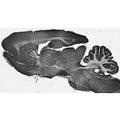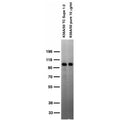Ships: 1-2 business days
Product Specific References for Applications and Species
- Immunocytochemistry: Chicken | Human | Mouse | Rat
- Immunohistochemistry: Chicken | Mouse | Non-Human Primate | Rat
- Immunoprecipitation: Mouse
- Western Blot: Chicken | Human | Mouse | Rat
- Additional Publications: Unspecified
| Immunocytochemistry: Chicken | ||
| PMID | Dilution | Publication |
| 18072193 | 1:50 (supe) | Fischer, A.J., et al. 2008. Transient expression of LIM-domain transcription factors is coincident with delayed maturation of photoreceptors in the chicken retina.. Journal of Comparative Neurology, 584-603. |
| Immunocytochemistry: Human | ||
| PMID | Dilution | Publication |
| 29426960 | not listed | LaConte, L.E.W., et al. 2018. Two microcephaly-associated novel missense mutations in CASK specifically disrupt the CASK-neurexin interaction. Human Genetics, 231-246. |
| 26345709 | 1:500 | Andrews, R.E., et al. 2015. Plasma membrane Ca2+-ATPase 4: interaction with constitutive nitric oxide synthases in human sperm and prostasomes which carry Ca2+/CaM-dependent serine kinase.. Molecular Human Reproduction, 832-43. |
| Immunocytochemistry: Mouse | ||
| PMID | Dilution | Publication |
| 38472649 | 1:100 | Campos, J., et al. 2024. Liprin-α proteins are master regulators of human presynapse assembly. Nature Neuroscience, . |
| 24011083 | 1:50,000 | Green, J.A., et al. 2013. Whirlin, a cytoskeletal scaffolding protein, stabilizes the paranodal region and axonal cytoskeleton in myelinated axons.. BMC Neuroscience, 96. |
| Immunocytochemistry: Rat | ||
| PMID | Dilution | Publication |
| 33037075 | not listed | Han, A.K., et al. 2020. LAR-RPTPs Directly Interact with Neurexins to Coordinate Bidirectional Assembly of Molecular Machineries. Journal of Neuroscience, 8438-8462. |
| 29983322 | not listed | Schroeder, A., et al. 2018. A Modular Organization of LRR Protein-Mediated Synaptic Adhesion Defines Synapse Identity. Neuron, 329-344.e7. |
| 29610457 | 1:1000 | Gao, R., et al. 2018. CNTNAP2 stabilizes interneuron dendritic arbors through CASK.. Mol Psychiatry Journal, . |
| 28533267 | not listed | Pinatel, D., et al. 2017. The Kv1-associated molecules TAG-1 and Caspr2 are selectively targeted to the axon initial segment in hippocampal neurons. Journal of Cell Science, 2209-2220. |
| Immunohistochemistry: Chicken | ||
| PMID | Dilution | Publication |
| 21031560 | 1:200 | Wahlin, K.J., et al. 2010. Alternative splicing of neuroligin and its protein distribution in the outer plexiform layer of the chicken retina.. Journal of Comparative Neurology, 4938-62. |
| Immunohistochemistry: Mouse | ||
| PMID | Dilution | Publication |
| 25352748 | 1:400 | de Andrade, G.B., et al. 2014. Developmentally dynamic colocalization patterns of DSCAM with adhesion and synaptic proteins in the mouse retina.. Molecular Vision, 1422-33. |
| 25176525 | 1:400 | Nuhn, J.S., et al. 2014. Developmental localization of adhesion and scaffolding proteins at the cone synapse. Gene expression patterns, 36-50. |
| Immunohistochemistry: Non-Human Primate | ||
| PMID | Dilution | Publication |
| 25176525 | 1:400 | Nuhn, J.S., et al. 2014. Developmental localization of adhesion and scaffolding proteins at the cone synapse. Gene expression patterns, 36-50. |
| Immunohistochemistry: Rat | ||
| PMID | Dilution | Publication |
| 27364017 | not listed | Eichel, C.A., et al. 2016. Lateral Membrane-Specific MAGUK CASK Down-Regulates NaV1.5 Channel in Cardiac Myocytes. Circulation Research, 544-56. |
| Immunoprecipitation: Mouse | ||
| PMID | Dilution | Publication |
| 31368584 | not listed | Brouwer, M., et al. 2019. SALM1 controls synapse development by promoting F-actin/PIP2-dependent Neurexin clustering. EMBO Journal, e101289. |
| 29370405 | 1:500 | Bathala, P., et al. 2018. Oviductal extracellular vesicles (oviductosomes, OVS) are conserved in humans: murine OVS play a pivotal role in sperm capacitation and fertility. Molecular Human Reproduction, 143-157. |
| 27015872 | 1:100 | LaConte, L.E.W., et al. 2016. CASK stabilizes neurexin and links it to liprin-α in a neuronal activity-dependent manner. Cellular and Molecular Life Science, 3599-621. |
| 23699388 | not listed | Patel, R., et al. 2013. Plasma membrane Ca2+-ATPase 4 in murine epididymis: secretion of splice variants in the luminal fluid and a role in sperm maturation.. Biology of Reproduction, 6. |
| 22020416 | not listed | Aravindan, R.G., et al. 2012. CASK interacts with PMCA4b and JAM-A on the mouse sperm flagellum to regulate Ca2+ homeostasis and motility.. Journal of Cellular Physiology, 3138-50. |
| Western Blot: Chicken | ||
| PMID | Dilution | Publication |
| 21031560 | 1:200-1:1000 | Wahlin, K.J., et al. 2010. Alternative splicing of neuroligin and its protein distribution in the outer plexiform layer of the chicken retina.. Journal of Comparative Neurology, 4938-62. |
| Western Blot: Human | ||
| PMID | Dilution | Publication |
| 37543038 | 1:1000 | Essayan-Perez, S, et al. 2023. Neuronal γ-secretase regulates lipid metabolism, linking cholesterol to synaptic dysfunction in Alzheimer's disease. Neuron, . |
| 29426960 | not listed | LaConte, L.E.W., et al. 2018. Two microcephaly-associated novel missense mutations in CASK specifically disrupt the CASK-neurexin interaction. Human Genetics, 231-246. |
| 26345709 | 1:1000 | Andrews, R.E., et al. 2015. Plasma membrane Ca2+-ATPase 4: interaction with constitutive nitric oxide synthases in human sperm and prostasomes which carry Ca2+/CaM-dependent serine kinase.. Molecular Human Reproduction, 832-43. |
| Western Blot: Mouse | ||
| PMID | Dilution | Publication |
| 38472649 | 1:1000 | Campos, J., et al. 2024. Liprin-α proteins are master regulators of human presynapse assembly. Nature Neuroscience, . |
| 37190086 | 1:1000-1:2000 | Guo, Q., et al. 2023. Structural Analysis Implicates CASK-Liprin-α2 Interaction in Cerebellar Granular Cell Death in MICPCH Syndrome. Cells, 1177. |
| 36262316 | 1:1000 | McSweeney, D., et al. 2022. CASK Loss of Function Differentially Regulates Neuronal Maturation and Synaptic Function in Human Induced Cortical Excitatory Neurons. iScience, 105187. |
| 34758294 | not listed | Wang, J., et al. 2021. RTN4/NoGo-receptor binding to BAI adhesion-GPCRs regulates neuronal development. Cell, 5869-5885. |
| 32552840 | not listed | Han, K.A., et al. 2020. Receptor Protein Tyrosine Phosphatase Delta Is Not Essential for Synapse Maintenance or Transmission at Hippocampal Synapses. Molecular Brain, 94. |
| 32516721 | not listed | Han, K.A., et al. 2020. PTPσ Controls Presynaptic Organization of Neurotransmitter Release Machinery at Excitatory Synapses. iScience, 101203. |
| 32202499 | 1:1000 | Zhang, R.S., et al. 2020. Latrophilin-2 and latrophilin-3 are redundantly essential for parallel-fiber synapse function in cerebellum. Elife, e54443. |
| 32160554 | 1:1000 | De Rossi, P., et al. 2020. Neuronal BIN1 Regulates Presynaptic Neurotransmitter Release and Memory Consolidation. Cell Reports, 3520-3535.e7. |
| 32134527 | 1:1000 | Luo, F., et al. 2020. Neurexins cluster Ca 2+ channels within the presynaptic active zone. EMBO Journal, e103208. |
| 31985401 | 1:1000 | Sclip, A. , et al. 2020. LAR receptor phospho-tyrosine phosphatases regulate NMDA-receptor responses. Elife, e53406. |
| 31985401 | 1:1000 | Sclip, A. , et al. 2020. LAR receptor phospho-tyrosine phosphatases regulate NMDA-receptor responses. Elife, e53406. |
| 31745231 | not listed | Han KA, et al. 2019. Slitrk2 controls excitatory synapse development via PDZ-mediated protein interactions. Scientific Reports, 17094. |
| 31262725 | 1:1000 | Trotter, J.H., et al. 2019. Synaptic neurexin-1 assembles into dynamically regulated active zone nanoclusters. Journal of Cell Biology, 2677-2698. |
| 31262725 | 1:1000 | Trotter, J.H., et al. 2019. Synaptic neurexin-1 assembles into dynamically regulated active zone nanoclusters. Journal of Cell Biology, 2677-2698. |
| 30451289 | not listed | Vaden, J.H., et al. 2019. Chronic over-expression of ubiquitin impairs learning, reduces synaptic plasticity, and enhances GRIA receptor turnover in mice. Journal of Neurochemistry, 386-399. |
| 30586380 | not listed | Favaro, P.D., et al. 2018. An opposing function of paralogs in balancing developmental synapse maturation. Plos Biology, e2006838. |
| 29370405 | 1:1000 | Bathala, P., et al. 2018. Oviductal extracellular vesicles (oviductosomes, OVS) are conserved in humans: murine OVS play a pivotal role in sperm capacitation and fertility. Molecular Human Reproduction, 143-157. |
| 27720444 | 1:1000 | Nafzger, S., et al. 2017. Calcium/calmodulin-dependent serine protein kinase CASK modulates the L-type calcium current. Cell Calcium, 10-21. |
| 27036546 | not listed | Srivastava, S., et al. 2016. X-linked intellectual disability gene CASK regulates postnatal brain growth in a non-cell autonomous manner. Acta Neuropathol Commun, . |
| 26085624 | 1:2000 | Tindi, J.O., et al. 2015. ANKS1B Gene Product AIDA-1 Controls Hippocampal Synaptic Transmission by Regulating GluN2B Subunit Localization.. Journal of Neuroscience, 8986-96. |
| 25904804 | 1:1000 | Fernandes, H.B., et al. 2015. Epac2 Mediates cAMP-Dependent Potentiation of Neurotransmission in the Hippocampus.. Journal of Neuroscience, 6544-53. |
| 24795561 | 1:1000 | Lugo, J.N., et al. 2014. Deletion of PTEN produces autism-like behavioral deficits and alterations in synaptic proteins.. Frontiers in Molecular Neuroscience, 27. |
| 24448406 | not listed | Li, Q., et al. 2014. The splicing regulator PTBP2 controls a program of embryonic splicing required for neuronal maturation.. Elife, e01201. |
| 23699388 | 1:1000 | Patel, R., et al. 2013. Plasma membrane Ca2+-ATPase 4 in murine epididymis: secretion of splice variants in the luminal fluid and a role in sperm maturation.. Biology of Reproduction, 6. |
| 23209303 | 1:1000 | Cheadle, L., et al. 2012. The novel synaptogenic protein Farp1 links postsynaptic cytoskeletal dynamics and transsynaptic organization.. The Journal of Biology, 985-1001. |
| 22020416 | 1:300 | Aravindan, R.G., et al. 2012. CASK interacts with PMCA4b and JAM-A on the mouse sperm flagellum to regulate Ca2+ homeostasis and motility.. Journal of Cellular Physiology, 3138-50. |
| 21145003 | 1:1000 | Robbins, E.M., et al. 2010. SynCAM 1 adhesion dynamically regulates synapse number and impacts plasticity and learning.. Neuron, 894-906. |
| Western Blot: Rat | ||
| PMID | Dilution | Publication |
| 29934346 | not listed | Han, K.A., et al. 2018. PTPσ Drives Excitatory Presynaptic Assembly via Various Extracellular and Intracellular Mechanisms. Journal of Neuroscience, 6700-6721. |
| 27364017 | not listed | Eichel, C.A., et al. 2016. Lateral Membrane-Specific MAGUK CASK Down-Regulates NaV1.5 Channel in Cardiac Myocytes. Circulation Research, 544-56. |
| 23622064 | not listed | Boyken, J., et al. 2013. Molecular profiling of synaptic vesicle docking sites reveals novel proteins but few differences between glutamatergic and GABAergic synapses.. Neuron, 285-97. |
| 20368431 | 1:1000 | Stagi, M., et al. 2010. SynCAM 1 participates in axo-dendritic contact assembly and shapes neuronal growth cones.. PNAS: USA, 7568-73. |
| Additional Publications: Unspecified | ||
| PMID | Publication | |
| 26496923 | Kamijo, A., et al. 2016. Immunohistochemical study of the membrane skeletal protein, membrane protein palmitoylated 6 (MPP6), in the mouse small intestine.. Histochemistry and Cell Biology, 81-92. | |
| 25123431 | Anjum, R., et al. 2014. Differential synaptic distribution of the scaffold proteins Cask and Caskin1 in the bovine retina.. Molecular and Cellular Neuroscience, 19-29. | |
| 24259518 | Dagley, L.F., et al. 2014. Quantitative proteomic profiling reveals novel region-specific markers in the adult mouse brain. Proteomics, 241-61. | |
| 23791195 | Wentzel, C., et al. 2013. mSYD1A, a mammalian synapse-defective-1 protein, regulates synaptogenic signaling and vesicle docking.. Neuron, 1012-23. | |
| 19620977 | Jeyifous, O., et al. 2009. SAP97 and CASK mediate sorting of NMDA receptors through a previously unknown secretory pathway. Nature Neuroscience, 1011-9. | |
| 19022416 | Klemmer, P., et al. 2009. Proteomics analysis of immuno-precipitated synaptic protein complexes.. Journal of Proteomics, 82-90. | |
| 18076030 | Wahlin, K.J., et al. 2008. Molecular dynamics of photoreceptor synapse formation in the developing chick retina.. Journal of Comparative Neurology, 822-37. | |



![Immunoblot against crude membrane fractions from whole mouse (MBM) or rat (RBM) brain and from human cerebellum [HBM(Cb)], cerebral cortex [HBM(Cx)] or hippocampus [HBM(H)] and probed with K56A/50 (left) or N52A/42 (right) TC supe.](http://www.antibodiesinc.com/cdn/shop/products/validation-image-73-000-k56a-50-wb-2_120x120.jpg?v=1626902818)


